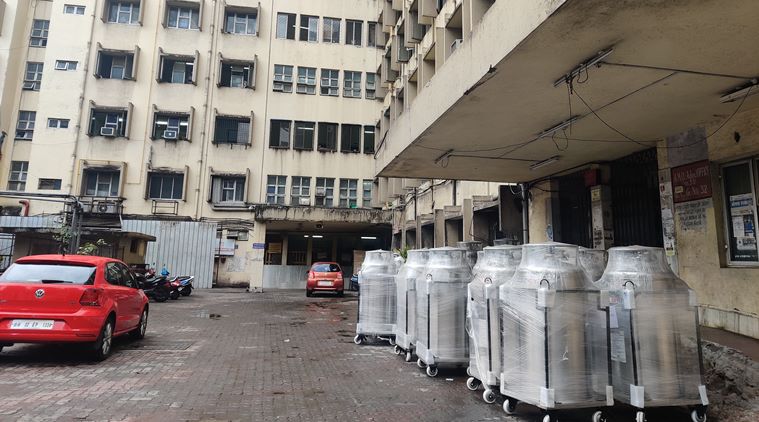 In Bandra Bhabha Hospital, oxygen cylinders placed near the entrace. (Express Photo)
In Bandra Bhabha Hospital, oxygen cylinders placed near the entrace. (Express Photo)
As the number of Covid-19 patients surges, with most of them in need of oxygen support, the Brihanmumbai Municipal Corporation (BMC) is battling with a new complaint in its hospitals: ‘Low oxygen pressure’.
The Indian Express found that in many civic hospitals that are now full-fledged Covid facilities, existing provisions for patients needing oxygen support is inadequate to handle what is now a huge load of patients with respiratory problems.
Every few days, say doctors, a distress call goes out to the engineering department at Bhaba Bandra hospital from the fifth floor intensive care unit, where there are 10 critical Covid-19 patients. One day last week, the pressure in the piped oxygen supply to beds dropped to 20 psi (pounds per square inch) in the ward. A 41-year-old’s oxygen saturation level dropped to 90, and then further down to 62. He became unconscious and could no longer breathe.
“I thought he would die. We rushed an oxygen cylinder to his bed. I used all possible medicines to stabilise him,” a doctor said.
A Covid-19 patient, depending on his condition, requires 2 litres-8 litres of oxygen in a minute. A senior intensivist said, “For patients on ventilator or intensive care support, 58 to 87 psi must be maintained, otherwise they do not get enough oxygen required in body. Lower pressure can attack their lung functioning.”
It took 20 minutes for a technician to restore the pressure. The man survived. “But his lungs took a hit due to sudden drop in pressure,” the doctor said, adding that three patients that day turned critical due to a drop in the oxygen pressure in the ICU. Two doctors and two nurses scrambled to get oxygen cylinders.
On June 11, doctors complained to the hospital administration about the oxygen pressure issue. Senior doctors said in the last one month the oxygen pressure has dropped below 70 psi “several times”, putting at risk lives of several breathless Covid-19 patients.
Oxygen consumption in the hospital has gone up eight times since the pandemic began. A hospital technician said earlier the requirement was for 35 oxygen cylinders a day. Now it has risen to 300 cylinders daily. Three wards at the hospital, including ICU, have Covid-19 patients.
At Nair hospital, faced with low oxygen pressure problems, Covid-19 admission has been shut down for several medical intensive care unit beds. Senior doctors said the management was forced to take this decision to ensure the remaining beds received adequate oxygen pressure. “It was a harsh decision to not admit patients even though we had beds,” a doctor said.
Nair hospital is a dedicated Covid facility.
“Last week the oxygen pressure dropped, and patients had to be shifted from one ward to another. It was a tense situation,” a doctor said. The hospital’s medicine department head has written to the dean to resolve this matter at the earliest.
Doctors have pointed out that for three weeks, several ICU beds remain vacant at a time when there is a dearth of intensive care unit beds.
The dean, Dr Mohan Joshi, denied there was a problem with the oxygen pressure, but said work to double the oxygen tank capacity was underway. He said the hospital had also procured dura cylinders. “They have 25 times enhanced capacity to provide oxygen,” he said.
The hospital ordered an oxygen tanker once in two days until March. Since April, when it became a dedicated Covid hospital, the frequency has become three times a day.
Why oxygen pressure is important, and how a drop affects Covid-19 patients
Covid-19 patients suffer a common clinical symptom: hypoxia, meaning low oxygen saturation in the body. Any patient with oxygen saturation below 95 needs external oxygen support. About 10 per cent of total Covid-19 patients require oxygen. The right amount of oxygen at the correct pressure will stabilise their breathing.
Oxygen is supplied to patients in different ways: a bed-side oxygen cylinder, or massive tanks from where pipelines run to various wards, or oxygenators — portable machines with compressed oxygen.
BMC-run hospitals mostly rely on tanks installed in a secure area on the ground floor from where it is piped up to wards. Since respiratory illnesses were uncommon before the pandemic, not all hospital wards are equipped with oxygen. The pipelines in these hospitals are old and prone to leakages.
In KEM hospital, there are two oxygen tanks and pipeline was put in place in the 1990s, former dean Dr Avinash Supe said. Nair and Sion hospital have one tank each.
The oxygen pressure can drop if there is leakage or the tank has less oxygen or if too many patients draw oxygen from one outlet. Each hospital has technicians who are tasked to find leaks or reasons for drop in pressure and resolve it. It can take 15-20 minutes, and some time hours.
Civic hospitals are admitting patients beyond their capacity and the oxygen supply is less than demand. A doctor in KEM hospital said as a patient’s saturation level drops, the pressure and flow of external oxygen has to be increased. “External oxygen pressure at around 70 psi is considered ‘okay’, but if it drops lower, critical patients may get serious,” a doctor in KEM hospital said.
A ventilator starts beeping if oxygen supply drops below 70 psi. “And this is happening too often nowadays,” said a doctor in KEM hospital, which has an 8 kilo litre capacity tank. It now plans to upgrade it to a 13 kilo litre.
Suresh Kakani, additional municipal commissioner, BMC, said there are enough oxygen cylinders present in hospitals even if oxygen pressure drops. “The situation in under control. We are also upgrading our capacity,” he said.
Dr Hemant Deshmukh, dean in KEM hospital, said, “Whenever oxygen tank capacity reaches 70 per cent, we top up with more oxygen to maintain pressure. We are also increasing our capacity.”